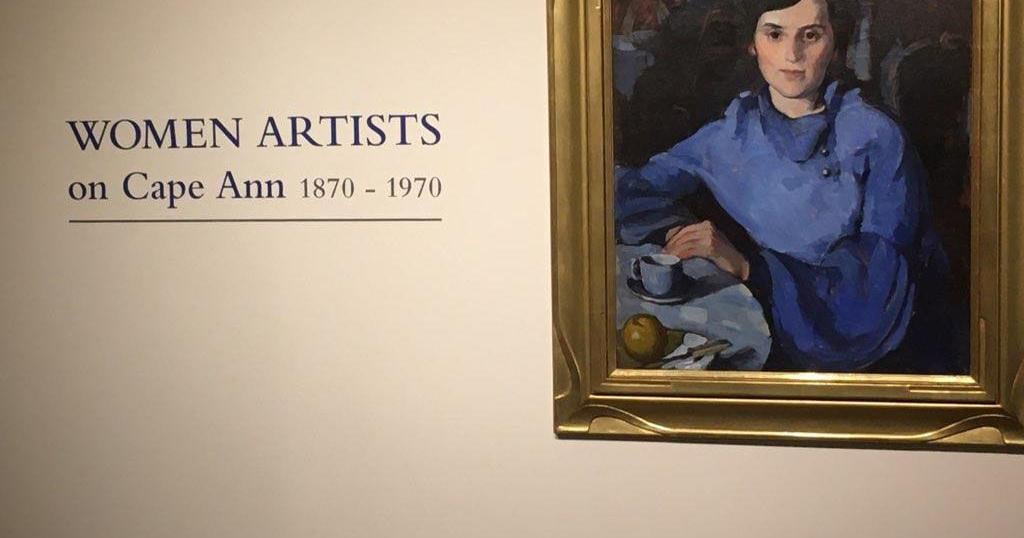Cape Ann Museum’s third-floor galleries are currently home to a gorgeous exhibit titled “Women Artists on Cape Ann 1870-1970.” That title seems oddly incomplete, as the exhibit features some of the most highly recognized women artists working on Cape Ann today.
These are 21st century women creating 21st century art in the visual language of today, and the museum has paid them homage by including a small selection of their works in the spacious gallery to the right as you enter — a sparse but stunningly mounted collection that is every bit the equal of the larger collection of its traditional, densely mounted earlier works.
These earlier works, dozens of them, are by women long established as revered icons of Cape Ann’s treasured art history, and include Audella Della Hyatt, Adelaide Cole Chase, Rosamond Smith Bouvé, Cecilia Beaux, Martha Walter, Mary Shore and Eva Matz.
Their works, richly rooted in 19th and early 20th century Impressionist-influenced French and Boston schools, are a trove of masterly elegant portraits, seascapes, landscapes, and still lifes of a bygone genteel Yankee New England, along with plein air paintings that capture the quaint charm and colors of Cape Ann’s villages, coves, streetscapes and gardens, bathed in the sea light that’s drawn artists for centuries.
By fascinating contrast, the modern works of today’s women artists are dynamic, vibrant and include the big, bold, powerful abstracts of Ruth Mordecai; the deep, darkly conceptually haunting works of Susan Erony; the dense earthy tangle of roots and leaves and branches that draw us into Gabrielle Barzhagi’s Dogtown pastels; the explosive energy generated from the colorful palettes of Judi Rotenberg and Clara Wainright; and Debbie Clark’s giant fabulous fish.
These are artists who are recognized in Cape Ann’s current cultural community as trailblazers, yet in the language of the museum’s promotional literature, their work is described as a “complementary” “display.”
Jane Deering, whose newly expanded gallery is next to the museum and frequently draws a run-off of museum goers, is a champion of contemporary women artists working on Cape Ann today and, concurrent with the museum’s all-women show, is also holding an all-women show.
Deering says that visitors — both locals and out-of-towners — to her gallery are amazed by the depth and breadth of contemporary female artistic talent on Cape Ann. “It comes as a revelation,” she said, “even to people who’ve lived here all their lives.”
Women artists have in fact, always been an important part of Cape Ann Museum’s history. But perhaps because the museum — which was originally founded in 1870 as a society for history, science and literature — did not even include art until the 1930s when it began acquiring the vast collection of Fitz Henry Lane marine works, it remains associated with male-dominated coastal marine art.
Ideally, art, like so many other things, should not be genderized at all. At last year’s blockbuster Hopper exhibit, under the aegis of museum director Oliver Barker, Cape Ann Museum ensured that the works of Josephine Hopper were shown right beside those of her famous husband. Her pivotal role in relaunching his career right here in Gloucester was a highlight of the exhibit.
As Cape Ann Museum emerges from the 20th into the 21st century, and approaches its 150th anniversary, the downtown museum will close Oct. 7, for major, multimillion dollar renovations and expansion. New world-class gallery space will allow exhibitions to spread their wings.
With more room comes more potential for even greater exhibitions, including the one with which it will reopen — a major exhibition with the working title of “Avery, Gottlieb & Rothko: A Close-Knit Trio” presented in partnership with Phillips Collection in Washington, D.C.
The loan exhibition will place special emphasis on the inspiration that all three American artistic icons — Milton Avery, Mark Rothko, and Adolph Gottlieb _ derived from visits to Cape Ann and from each other.
Joann Mackenzie may be contacted at 978-675-2707 or jmackenzie@gloucestertimes.com.

